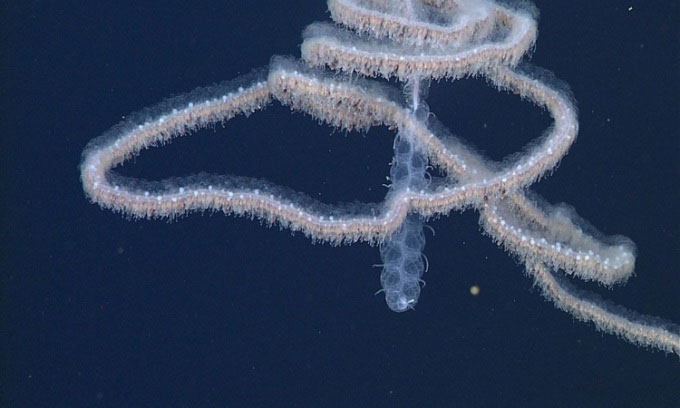Cloned creatures could be longer than blue whales
Siphonophores are unusual animals consisting of many individual organs called zooids, each zooid having a distinct function despite being genetically identical.
Siphonophore (Hydrophyte tube) called Siphonophora lives in every ocean around the world, specializing in eating small crustaceans, copepods and fish. This strange sea creature can be longer than the blue whale, the largest animal on Earth, reaching up to 46m in length, according to Live Science .

Siphonophores are colonies of genetically identical individuals. (Photo: MBARI)
There are about 175 species of siphonophores that live in the deep sea in all the oceans. Many siphonophores look like long ropes, but a few, like the poisonous fire jellyfish ( Physalia physalis ), look like jellyfish.
Although a siphonophore may appear to be a single animal, it is actually a colony of individual organisms called zooids, each with a specific function. Some zooids are specialized in capturing and digesting food, while others allow the colony to reproduce or swim. A zooid cannot survive on its own because it is specialized in performing a function, so it depends on each other to form its body. The siphonophore develops from a zooid that hatches from a fertilized egg. This first zooid develops a growth zone, from which new zooids grow. The siphonophore clones itself asexually to produce more and more zooids.
Siphonophores feed on a variety of small marine animals, including plankton, fish, and crustaceans . Zooids that use poison to catch prey have zooids equipped with small tentacles that contain paralyzing poison. To hunt, they swing out their tentacles to sting and immobilize their prey before pulling the food into their mouths. Marine biologists filmed a siphonophore feeding in Western Australia in 2020. They found that the giant 45.7-meter-long siphonophore ( Praya dubia ) created a deadly spiral to catch its prey off guard.
Many siphonophores are also bioluminescent, producing light through a chemical reaction to attract prey. While most species glow green or blue, a siphonophore species in the genus Erenna is the first invertebrate to glow red. Red bioluminescence is rare because the shorter wavelengths of green and blue travel farther in the ocean and are more evolutionarily useful to marine animals. According to a 2005 paper in Science by marine biologist Steven Haddock of the Monterey Bay Aquarium Research Institute, the red glow may attract fish because they mistake the red glow for algae in the stomachs of prey such as copepods.
Siphonophores are often preyed upon by sea turtles or larger fish. However, some species can use their stinging tentacles to defend themselves against predators. They are also preyed upon by tiny transparent crustaceans called phronima, which can bite through the siphonophores to live inside them, causing them to slowly die.
- Blue whales rotate 360 degrees to hunt
- Blue whales were first discovered in the Red Sea
- Strangely small creatures, but longer than blue whales
- Disaster turns blue whale into the largest creature on the planet
- 4 fictional creatures, but doubt it is 100% real
- Close up of the largest 170 ton blue whale on the planet
- A pair of male blue whales fight fiercely for a mate
- Whales do not know how to avoid boats
- 10 giant animals on the ocean floor
- How is the secret of feeding a whale?
- 'Fire Dragon' on the ocean floor
- Video: Whales familiarize people on the beach
 Surprised: Fish that live in the dark ocean still see colors
Surprised: Fish that live in the dark ocean still see colors Japan suddenly caught the creature that caused the earthquake in the legend
Japan suddenly caught the creature that caused the earthquake in the legend A series of gray whale carcasses washed ashore on California's coast
A series of gray whale carcasses washed ashore on California's coast Compare the size of shark species in the world
Compare the size of shark species in the world